反义疑问句对应规则17条
图片预览
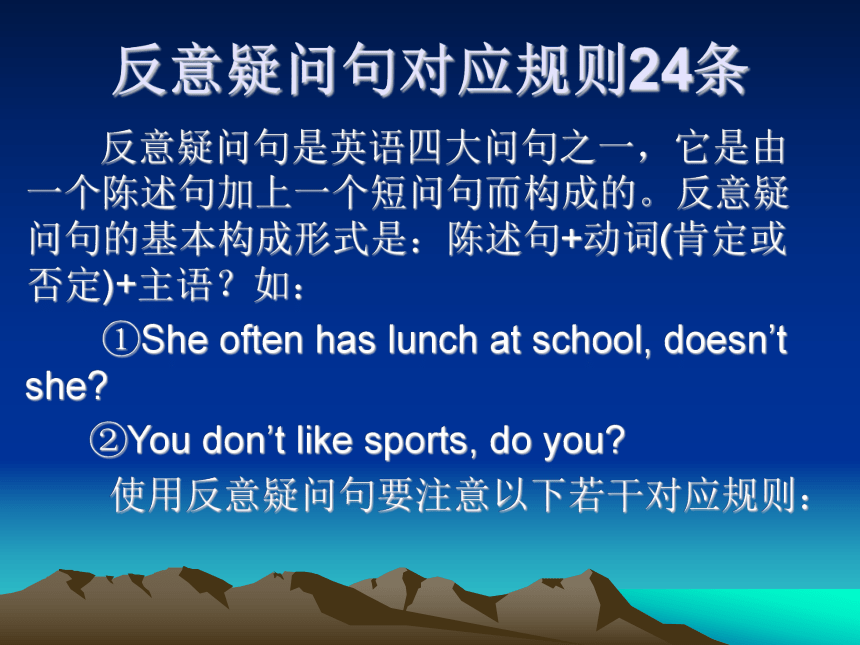
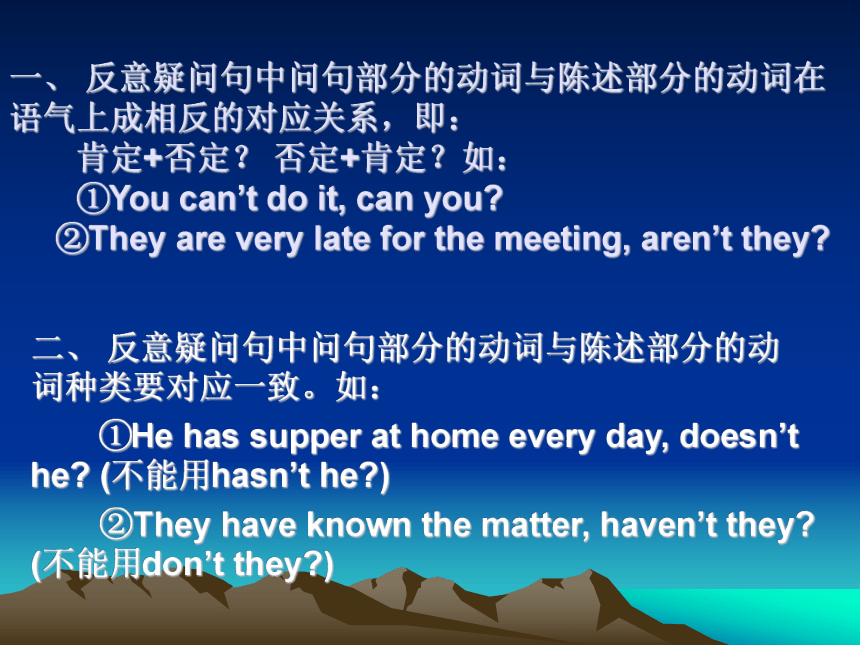
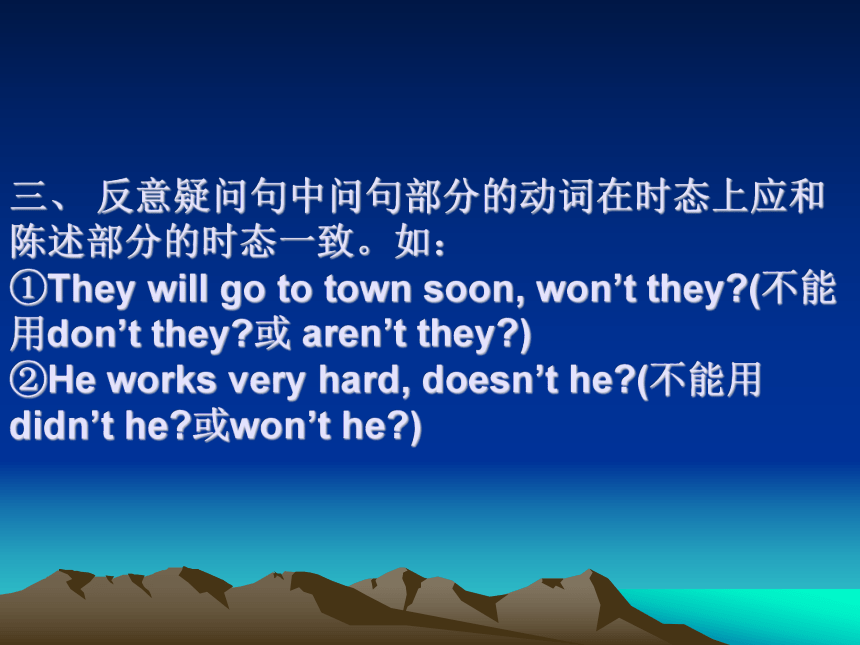
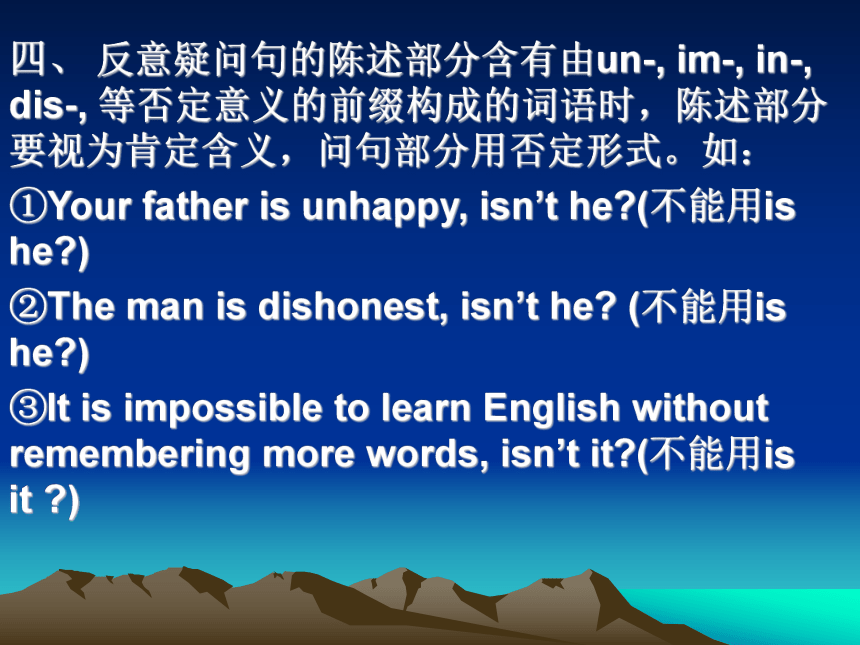
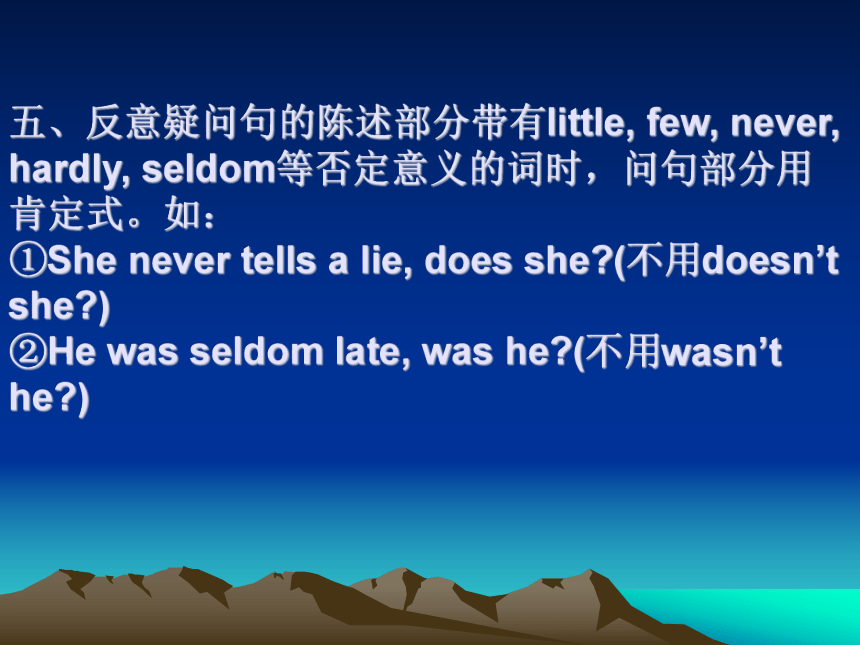
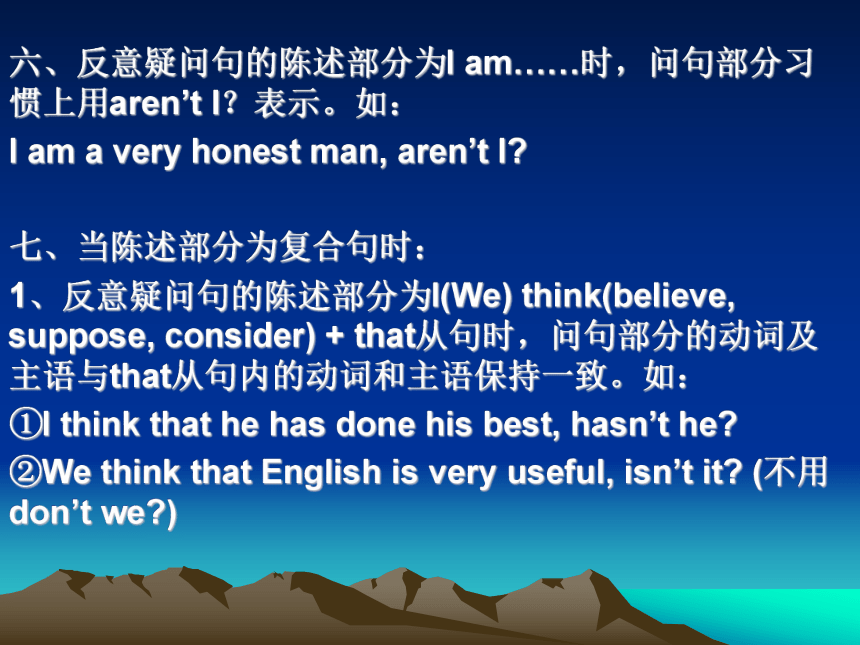
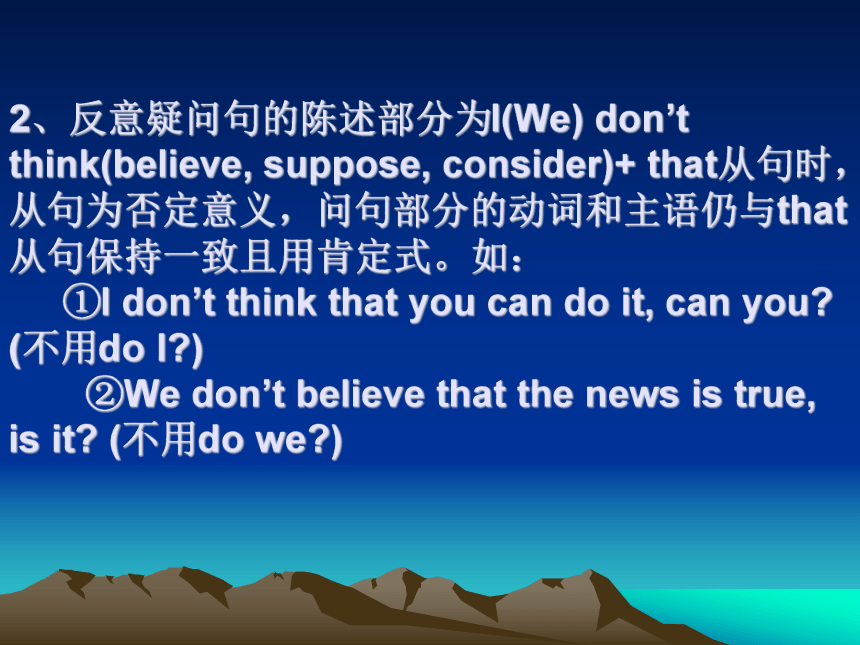
文档简介
(共20张PPT)
反意疑问句对应规则24条
反意疑问句是英语四大问句之一,它是由一个陈述句加上一个短问句而构成的。反意疑问句的基本构成形式是:陈述句+动词(肯定或否定)+主语?如:
①She often has lunch at school, doesn’t she
②You don’t like sports, do you
使用反意疑问句要注意以下若干对应规则:
一、 反意疑问句中问句部分的动词与陈述部分的动词在语气上成相反的对应关系,即:
肯定+否定? 否定+肯定?如:
①You can’t do it, can you
②They are very late for the meeting, aren’t they
二、 反意疑问句中问句部分的动词与陈述部分的动词种类要对应一致。如:
①He has supper at home every day, doesn’t he (不能用hasn’t he )
②They have known the matter, haven’t they (不能用don’t they )
三、 反意疑问句中问句部分的动词在时态上应和陈述部分的时态一致。如:
①They will go to town soon, won’t they (不能用don’t they 或 aren’t they )
②He works very hard, doesn’t he (不能用didn’t he 或won’t he )
四、 反意疑问句的陈述部分含有由un-, im-, in-, dis-, 等否定意义的前缀构成的词语时,陈述部分要视为肯定含义,问句部分用否定形式。如:
①Your father is unhappy, isn’t he (不能用is he )
②The man is dishonest, isn’t he (不能用is he )
③It is impossible to learn English without remembering more words, isn’t it (不能用is it )
五、反意疑问句的陈述部分带有little, few, never, hardly, seldom等否定意义的词时,问句部分用肯定式。如:
①She never tells a lie, does she (不用doesn’t she )
②He was seldom late, was he (不用wasn’t he )
六、反意疑问句的陈述部分为I am……时,问句部分习惯上用aren’t I?表示。如:
I am a very honest man, aren’t I
七、当陈述部分为复合句时:
1、反意疑问句的陈述部分为I(We) think(believe, suppose, consider) + that从句时,问句部分的动词及主语与that从句内的动词和主语保持一致。如:
①I think that he has done his best, hasn’t he
②We think that English is very useful, isn’t it (不用don’t we )
2、反意疑问句的陈述部分为I(We) don’t think(believe, suppose, consider)+ that从句时,从句为否定意义,问句部分的动词和主语仍与that从句保持一致且用肯定式。如:
①I don’t think that you can do it, can you (不用do I )
②We don’t believe that the news is true, is it (不用do we )
3、反意疑问句的陈述部分为非第一人称主语+ think(believe, suppose, consider) + that从句时,问句部分的动词和主语与陈述部分的主句动词和主语保持一致。如:
①They all think that English is very important, don’t they (不用isn’t it )
②He didn’t think that the news was true, did he (不用wasn’t/ was it )
八、反意疑问句的陈述部分为主语+said( told, reported, asked……) + that从句时,问句部分的动词和主语与陈述部分的主句动词和主语保持一致。如:
①They said that you had finished your work, didn’t they (不用hadn’t you)
②Kate told you that she would go there, didn’t she (不用wouldn’t she )
九、陈述部分的主语为指物的不定代词something, anything, nothing, everything时,问句部分的主语用it。陈述部分的主语为指人的不定代词somebody(someone), anybody(anyone), nobody(no one), everybody(everyone)时,问句部分的主语用he或 they,这时问句动词的数应和he或 they一致。如:
①Something is wrong with the computer, isn’t it
②Nothing has happened to them, has it 如:
③Someone has taken the seat, hasn’t he
④Everyone has done their best in the game, haven’t they
十、陈述部分为Let me……时,问句部分习惯上用shall I 或will you 形式。如:
Let me have a try, shall I (will you )
陈述部分为Let us……时,问句部分习惯上用will you 形式。如:
Let us stop to rest, will you
陈述部分为Let’s……时,问句部分习惯上用shall we 形式。如:
Let’s go home together, shall we
十一、陈述部分肯定祈使句时,问句部分一般用will you 形式表示请求,用won’t you?形式表示委婉请求或邀请。陈述部分为否定祈使句时,问句部分一般用will you 形式。如:
①Do sit down, won’t you / will you
②You feed the bird today, will you
③Please open the window, will you (won’t you )
④Don’t make any noise, will you
十二、陈述部分为There (Here) + be + 主语时,问句部分用动词+there(here) 形式。如:
①There are two cakes on the plate, aren’t there
②Here is a story about Mark Twain, isn’t here
十三、陈述部分用had better +原形动词表示建议时,问句部分用hadn’t +主语?形式。
①You’d better tell him about the matter, hadn’t you
②We had better do it by ourselves, hadn’t we
十四、陈述部分用used to +主语时,问句部分用didn’t + 主语?或usedn’t +主语?形式。
①He used to live in the country, didn’t he /usedn’t he
②They used to be good friends, didn’t they /usedn’t they
十五、陈述部分含有时
1、当must表“必须”时,疑问部分用needn’t。如:
She must stay at home, needn’t she
2、当mustn’t表“禁止”时,疑问部分用must。如:
You mustn’t play with fire, must you
3、当must表“一定;想必”等推测意义时,问句部分的助动词应和must后面的助动词相呼应。如:
It must be delicious, isn’t it
They must be playing basketball, aren’t they
十六、陈述部分的主语为从句时,问句部分的主语一般用it代替,如:
①What he said is true, isn't it (不用didn’t he )
②Where we will build the dam has not been decided yet, has it (不用won’t we )
十七、陈述部分的主语为动名词或不定式时,问句的主语用it代替。如:
①To do one good deed is easy for a person, isn't it
②Skating is your favorite sport, isn't it
反意疑问句对应规则24条
反意疑问句是英语四大问句之一,它是由一个陈述句加上一个短问句而构成的。反意疑问句的基本构成形式是:陈述句+动词(肯定或否定)+主语?如:
①She often has lunch at school, doesn’t she
②You don’t like sports, do you
使用反意疑问句要注意以下若干对应规则:
一、 反意疑问句中问句部分的动词与陈述部分的动词在语气上成相反的对应关系,即:
肯定+否定? 否定+肯定?如:
①You can’t do it, can you
②They are very late for the meeting, aren’t they
二、 反意疑问句中问句部分的动词与陈述部分的动词种类要对应一致。如:
①He has supper at home every day, doesn’t he (不能用hasn’t he )
②They have known the matter, haven’t they (不能用don’t they )
三、 反意疑问句中问句部分的动词在时态上应和陈述部分的时态一致。如:
①They will go to town soon, won’t they (不能用don’t they 或 aren’t they )
②He works very hard, doesn’t he (不能用didn’t he 或won’t he )
四、 反意疑问句的陈述部分含有由un-, im-, in-, dis-, 等否定意义的前缀构成的词语时,陈述部分要视为肯定含义,问句部分用否定形式。如:
①Your father is unhappy, isn’t he (不能用is he )
②The man is dishonest, isn’t he (不能用is he )
③It is impossible to learn English without remembering more words, isn’t it (不能用is it )
五、反意疑问句的陈述部分带有little, few, never, hardly, seldom等否定意义的词时,问句部分用肯定式。如:
①She never tells a lie, does she (不用doesn’t she )
②He was seldom late, was he (不用wasn’t he )
六、反意疑问句的陈述部分为I am……时,问句部分习惯上用aren’t I?表示。如:
I am a very honest man, aren’t I
七、当陈述部分为复合句时:
1、反意疑问句的陈述部分为I(We) think(believe, suppose, consider) + that从句时,问句部分的动词及主语与that从句内的动词和主语保持一致。如:
①I think that he has done his best, hasn’t he
②We think that English is very useful, isn’t it (不用don’t we )
2、反意疑问句的陈述部分为I(We) don’t think(believe, suppose, consider)+ that从句时,从句为否定意义,问句部分的动词和主语仍与that从句保持一致且用肯定式。如:
①I don’t think that you can do it, can you (不用do I )
②We don’t believe that the news is true, is it (不用do we )
3、反意疑问句的陈述部分为非第一人称主语+ think(believe, suppose, consider) + that从句时,问句部分的动词和主语与陈述部分的主句动词和主语保持一致。如:
①They all think that English is very important, don’t they (不用isn’t it )
②He didn’t think that the news was true, did he (不用wasn’t/ was it )
八、反意疑问句的陈述部分为主语+said( told, reported, asked……) + that从句时,问句部分的动词和主语与陈述部分的主句动词和主语保持一致。如:
①They said that you had finished your work, didn’t they (不用hadn’t you)
②Kate told you that she would go there, didn’t she (不用wouldn’t she )
九、陈述部分的主语为指物的不定代词something, anything, nothing, everything时,问句部分的主语用it。陈述部分的主语为指人的不定代词somebody(someone), anybody(anyone), nobody(no one), everybody(everyone)时,问句部分的主语用he或 they,这时问句动词的数应和he或 they一致。如:
①Something is wrong with the computer, isn’t it
②Nothing has happened to them, has it 如:
③Someone has taken the seat, hasn’t he
④Everyone has done their best in the game, haven’t they
十、陈述部分为Let me……时,问句部分习惯上用shall I 或will you 形式。如:
Let me have a try, shall I (will you )
陈述部分为Let us……时,问句部分习惯上用will you 形式。如:
Let us stop to rest, will you
陈述部分为Let’s……时,问句部分习惯上用shall we 形式。如:
Let’s go home together, shall we
十一、陈述部分肯定祈使句时,问句部分一般用will you 形式表示请求,用won’t you?形式表示委婉请求或邀请。陈述部分为否定祈使句时,问句部分一般用will you 形式。如:
①Do sit down, won’t you / will you
②You feed the bird today, will you
③Please open the window, will you (won’t you )
④Don’t make any noise, will you
十二、陈述部分为There (Here) + be + 主语时,问句部分用动词+there(here) 形式。如:
①There are two cakes on the plate, aren’t there
②Here is a story about Mark Twain, isn’t here
十三、陈述部分用had better +原形动词表示建议时,问句部分用hadn’t +主语?形式。
①You’d better tell him about the matter, hadn’t you
②We had better do it by ourselves, hadn’t we
十四、陈述部分用used to +主语时,问句部分用didn’t + 主语?或usedn’t +主语?形式。
①He used to live in the country, didn’t he /usedn’t he
②They used to be good friends, didn’t they /usedn’t they
十五、陈述部分含有时
1、当must表“必须”时,疑问部分用needn’t。如:
She must stay at home, needn’t she
2、当mustn’t表“禁止”时,疑问部分用must。如:
You mustn’t play with fire, must you
3、当must表“一定;想必”等推测意义时,问句部分的助动词应和must后面的助动词相呼应。如:
It must be delicious, isn’t it
They must be playing basketball, aren’t they
十六、陈述部分的主语为从句时,问句部分的主语一般用it代替,如:
①What he said is true, isn't it (不用didn’t he )
②Where we will build the dam has not been decided yet, has it (不用won’t we )
十七、陈述部分的主语为动名词或不定式时,问句的主语用it代替。如:
①To do one good deed is easy for a person, isn't it
②Skating is your favorite sport, isn't it
同课章节目录
- 词法
- 名词
- 动词和动词短语
- 动词语态
- 动词时态
- 助动词和情态动词
- 非谓语动词
- 冠词
- 代词
- 数词和量词
- 形容词副词及其比较等级
- 介词和介词短语
- 连词和感叹词
- 构词法
- 相似、相近词比较
- 句法
- 陈述句
- 一般疑问句和否定疑问句
- 特殊疑问句及选择疑问句
- 反意疑问句
- 存在句(There be句型)
- 宾语从句
- 定语从句
- 状语从句
- 主谓一致问题
- 简单句
- 并列句
- 复合句
- 主谓一致
- 主、表语从句
- 名词性从句
- 直接引语和间接引语
- 虚拟语气
- 感叹句
- 强调句
- 倒装句
- 祈使句
- 句子的成分
- 句子的分类
- 题型专区
- 单项选择部分
- 易错题
- 完形填空
- 阅读理解
- 词汇练习
- 听说训练
- 句型转换
- 补全对话
- 短文改错
- 翻译
- 书面表达
- 任务型阅读
- 语法填空
- 其他资料
